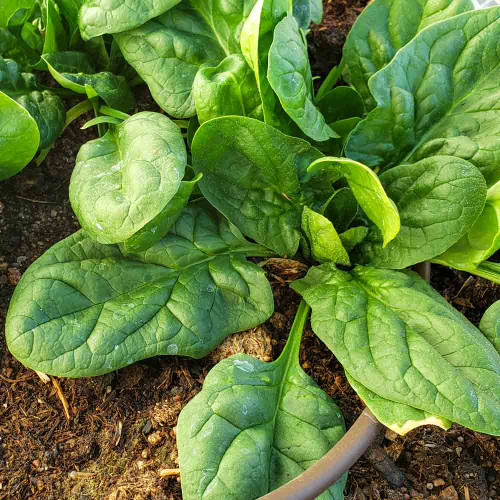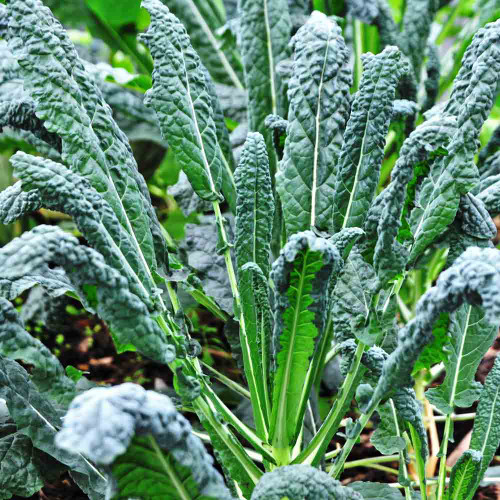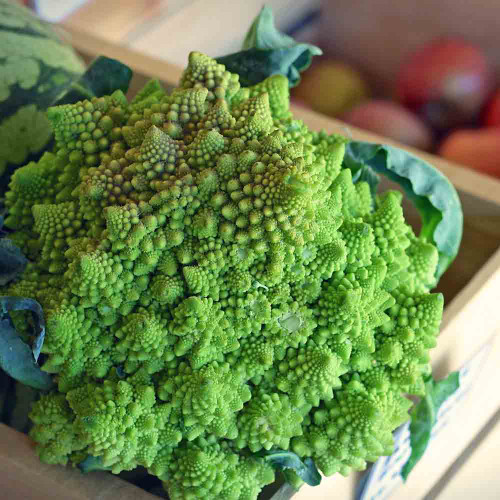Description
Viroflay Spinach - Rediscovering a French Heirloom
In the bustling markets of 19th century France, a remarkable spinach variety emerged, destined to become a gardener's favorite – Viroflay. This semi-savoyed heirloom is cherished for its robust growth, abundant yields, and tender, mild-flavored leaves that retain their sweetness even at maturity. As a bonus, Viroflay is naturally lower in oxalic acid, which is why some spinach varieties taste bitter or metallic. If you've been disappointed by bitter spinach in the past, Viroflay might be your perfect match.
With its impressive size, incredible flavor, and effortless growth, Viroflay spinach is a welcome addition to any garden, from sprawling backyard plots to compact container gardens on balconies and windowsills.
Details
This vigorous grower forms an upright, compact bush, reaching up to 6-12 inches tall and wide, boasting an abundance of oval, smooth, deep-green leaves. Its compact growth habit makes it ideal for smaller gardens or containers, and with its hardiness in USDA Zones 3-12, it's adaptable to a wide range of climates. Viroflay spinach is a rewarding and easy-to-grow choice. Enjoy fresh spinach as a spring or fall crop or even throughout the winter in milder regions.
Viroflay spinach prefers a sunny to partially shaded location and thrives in fertile, well-drained soil. Consistent moisture is key to preventing bolting, especially during the early stages of growth. While Viroflay is more heat-tolerant than other spinach varieties, it appreciates some shade during hot summer days to prolong leaf production and delay bolting. Consider planting it under taller plants, using shade cloth, or positioning it in an area with afternoon shade.
History
Spinach first took root in ancient Persia over 2,000 years ago. Prized for its nourishment and versatility, spinach quickly became a staple. Its name, "ispanai," meaning "green hand" in Persian, reflects the color of harvesting fresh leaves.
Spinach traveled ancient trade routes, reaching China by the 7th century as a gift from the king of Nepal. Centuries later, following the Moorish conquest, it crossed the Mediterranean, arriving in Spain in the 11th century, where its reputation as a nutritional powerhouse ensured its widespread adoption.
Spinach continued its westward migration to Italy, becoming a favorite of Catherine de Medici of Florence. In 1533, after marrying the French king, she brought spinach to the French court, where dishes featuring it were named "à la Florentine" in honor of her Italian heritage.
The story continued as explorers carried spinach seeds to new lands, including the Americas, where it became a prized staple in gardens and on tables.
In the 1500s, spinach was a popular Lenten food due to its early spring availability and "little taste." It was often enjoyed in sweet dumplings called 'espinoches'. Centuries later, in the 20th century, Popeye helped popularize the belief that spinach is rich in iron. Spinach also holds the distinction of being the first frozen vegetable sold commercially.
Located southwest of Paris, the town of Viroflay is renowned for its long and rich history of market gardening. While the exact origins of Viroflay spinach remain uncertain, it was likely first cultivated centuries ago, passed down through generations of farmers who carefully tended their crops in the region's fertile soil. By the 16th and 17th centuries, Viroflay spinach had established itself as a popular crop, renowned for its delicately sweet flavor and tender leaves. The farmers of Viroflay played a key role in supplying fresh produce to the renowned Les Halles market in Paris, the central hub for the city's food trade. Within the bustling atmosphere of Les Halles, Viroflay spinach was particularly prized by the city's chefs and residents.
Its hardiness, especially its ability to withstand cold temperatures, made it a perfect choice for the region's climate and may have been an important factor in its selection and cultivation. The variety's French name, 'Monstrueux de Viroflay' (Monster of Viroflay), highlights its large leaves, a key characteristic distinguishing it from other spinach varieties at the time.
It is considered an endangered heirloom listed on the Slow Food organization's Ark of Taste.
Uses
Viroflay spinach is a versatile culinary ingredient, delicious both raw and cooked. Its tender leaves and mild, sweet flavor make it perfect for salads, sautés, and side dishes. Enjoy it in sandwiches, wraps, smoothies, and grain bowls. Viroflay spinach can also be sautéed, stir-fried, wilted, or steamed, and incorporated into egg dishes, dips, pasta, and pizzas. It pairs well with aromatics like garlic and shallots, aged cheeses, fruits, meats, seafood, and eggs.
Companion Planting
Companion planting involves growing different plants together to benefit each other. Here are some beneficial and antagonistic pairings for Viroflay spinach:
Beneficial Pairings
Brassicas (broccoli, cabbage, cauliflower) and legumes (peas, beans) enrich the soil by fixing nitrogen, essential for vigorous spinach growth.
Create a protective border around your spinach bed with marigolds and nasturtiums, their bright blooms deterring pests. Alliums (chives, garlic, onions) also repel pests with their strong scent while providing shade and support for low-growing spinach plants. Herbs like basil, thyme, and dill act as natural pest repellents, attracting beneficial insects that help protect your spinach. When young, Dill is an excellent companion plant, but mature dill can cause the plants around it to become stunted.
Interplanting rows of spinach and peas creates a mutually beneficial pairing, with the peas providing vertical support and the spinach offering ground cover to suppress weeds. Strawberries also thrive alongside spinach, enjoying the cool shade cast by its leaves.
Antagonistic Pairings
Potatoes compete aggressively with spinach for nutrients and water, hindering its growth.
Fennel releases chemicals that inhibit spinach growth, while mint's spreading nature can crowd out spinach, limiting its access to resources.
Pest and Disease Management
Though generally hardy, Viroflay spinach can be susceptible to pests like aphids, flea beetles, and leaf miners. Organic control methods, such as attracting natural predators like ladybugs and lacewings, are effective and environmentally friendly. Hand-picking larger pests and using a strong stream of water can also help. To prevent downy mildew, avoid planting spinach in the same location year after year, ensure proper air circulation, and promptly remove any diseased plants.
Planting and Growing Tips
For a thriving spinach patch, enrich the soil with compost and plant in early spring or late summer, sowing seeds ½ inch deep and ½ inch apart, with rows 12-18 inches apart. Thin seedlings to 4-5 inches apart when they reach 2 inches tall. Maintain consistent moisture and provide shade in warmer weather. Viroflay spinach thrives in cool temperatures (50-70°F). In mild climates, sow in mid-August for an early spring harvest and protect plants with a cloche or row cover during the winter.
Harvest Tips
When it's time to harvest, head out to your garden in the morning or evening, avoiding the hottest part of the day, as higher nitrate levels in the morning can sometimes lead to a slightly bitter taste. You can begin harvesting baby leaves in just 21 days when they reach 3-4 inches long. Mature leaves will be ready for harvest in 40-50 days. For the best flavor, harvest before the plant bolts. You can pluck individual leaves at any time or harvest the entire plant by cutting it just above the soil level.















